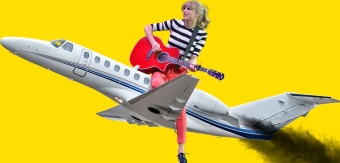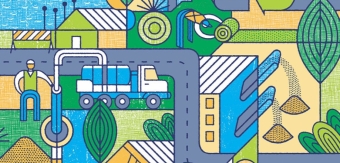Tom Guy is Commercial & Product Director at Hive, a British Gas innovation. Despark, an International digital specialist, spoke to him to find out what it takes to create a cutting-edge, offshoot as part of a 200-year-old legacy company and to hear about how to build products around specific consumer needs and use cases. We also got a sneak peek into the future of Hive and their upcoming products.
What is the background of the Hive project as a whole?
British Gas had a product called Remote Heating Control (RHC). It was launched about 18 months to two years before Hive 1. The product was OK: it had a few of the features that are in Hive, the design was OK for back then. One of the challenges was the distribution of it. It probably didn't encompass all of the features that customers wanted. However, what was very apparent was that the people that used it used it a lot. They really got something out of it.
From a British Gas point of view, they could see that there was a product there. They were aware of the smart home [concept], and realised a move into this space needed to be done differently– it couldn’t be done within British Gas. That's how Hive started: not just as a product, but as a thing, an entity as well. It was as important to set that entity up correctly as it was for the product.
"If there's not a customer in our offices every single day looking at a feature or a design or a button, then we're doing something wrong."
Obviously the technology has mostly been brand new, but was there any sort of precedent for what you were trying to build in other industries or markets in terms of a user-controlled ecosystem?
It's a native market now, but only now have some of the bigger companies started to get into it. We are built on Agile and Lean design principles and what that basically means for anyone who isn't technical is that the customer is always right at the heart of something. I don't mean that in a corporate way; I mean that if there's not a customer in our offices every single day looking at a feature or a design or a button, then we're doing something wrong.
We believe that from that original inception of RHC there was something that customers loved, so it was drawing that out more. What are the features people want? That's where it starts, and then you overlay that with any other market components: competitor products, price, demographics. The base level is – what does the customer want? What are the problems we're trying to solve?
I always start from a principle of wanting that magical moment, that engagement in a product that just changes – in however small way – that person's life. The example I always give is the first time I pressed Sky+. The example that people give now are things like Hailo and UBER and paying for parking meters around London. Our moment of truth around design at Hive, our little way of changing the world, was going from a point where no-one can set a schedule on their current thermostats to almost everyone being able to. That, in a small way, is revolutionary in the little part of the world that we're working in.
"I always start from a principle of wanting that magical moment, that engagement in a product that just changes – in however small way – that person's life."
Were all the products designed and envisaged from the start or were some created in response to others or in reaction to consumer feedback and research?
It has to start with the customer need, with that use case. I say that knowing that a good product person will also try to describe or envisage something that a customer can't completely articulate. The Ford example's always a good one. If they had asked customers what they wanted, they'd have asked for a faster horse.
Customers won't say they need a recipe for a motion sensor and a smart bulb and geo-location; what they'll say is "it would be really nice to know when my daughter arrives home and the back door's open". They'll talk about problems or experiences. "It would be really nice to know if my dog's barking at home" – what could I do with that? "I've got smoke and CO detectors around the house. They're not connected. When they go off, why don't I know that even if I'm not in my house?" Then it's our job to work out if that's a physical product [or] if it's a software product. A lot of the time it takes some form of data to bring all those things together.
What considerations were taken into account when developing the Hive brand personality?
That comes back down to Hive coming out of a 200+ year old company. We needed something fun; we needed maybe a bit more casual language. If you think about how customers are going to interact with us on helplines, it's going to be a lot more free language because obviously we're not a regulated business in terms of smart home. We were also going to go into areas that British Gas can't go into, so we needed a brand that allowed us to do that. Our brand is also going up against some of the smartest, newest, innovative business coming out of Silicon Valley, so we have different competitor sets that we were needing to go against.
What have you found to be the biggest challenge in terms of communicating what Hive is all about to consumers? It's still a very new field in relative terms...
I think the biggest problem we're all facing in this industry is – is it actually useful to me? Is it going to change my life? If I said to you “you can now control your thermostat on your phone”, it's a bit of a – 'so what?' But I think the first person who said “I'm going to give you a remote control for your TV” probably thought the same. It was that type of shift that we needed to make.
I think that challenge really comes down to when customers can really see it, try it and feel it, they really become advocates. We've got a 90%+ recommendation rate on the products to family and friend, so we’re clearly doing something right for them to be recommending us to close people around them. I think that's where the partnership with British Gas really does flourish because if you think about it, we've got around 8,000 engineers going into homes talking about your heating, and sometimes being the saviour too. Those guys aren't sales people; they're going in telling you and advising you of the best stuff, and many of the engineers have got Hive, so they can actually talk about it as a customer.
In early 2015, Hive / British Gas acquired AlertMe who provide the backbone for your motion sensor technology. What learnings do you have on the acquisition / integration process and how this enabled you to build better products?
First of all, AlertMe were far more than just motion sensor technology; they were the platform. When you look at a platform, there are loads of building blocks, but if you imagine the biggest part of the engine if you like, it made sense for Centrica to own the heartbeat of the product. Those conversations started very early on. In terms of that whole transition and bringing them on board, if you imagine at the time we were about the same size as them. The lucky thing is that there wasn't much of a crossover. What we were bringing in was engineers, data scientists –real platform gurus. What we had were front-end developers; designers; product people; commercial. It was a real nice fit. I think when the AlertMe guy came in and they felt the vibe and the culture, it was very akin to theirs.
"You can't act like a startup; you have to be a startup"
We're seeing more and more big corporations, brands and agencies set up incubator-style side companies and departments. Would you say that Hive serves a similar purpose for British Gas?
No, I don't think so. I think we have a clear objective that we want to build amazing products that change customers' lives. That's not really being an incubator. We do things differently because we have to, because our competitors are the startups, the Googles... they work in an Agile and Lean manner and they have done for years, so it's nothing new to them. I think maybe the way that Centrica and British Gas can view us is that if there are ideas that they would like to see if they have momentum or want to see if something's there, they can throw them over to us and we can do an Agile sprint on something. We hopefully are innovative, but I don't think we're 'innovation from within'.
I think there's something I always talk about which is that you can't actlike a startup; you have to be a startup. The way that most people have been brought into this business is that they're not energy people. They are from startups and from other industries – Telco, TV, things that are very fast-moving. Over the last three years we've been able to marry that up nicely with a good percentage of people from Centrica and British Gas, so we've got a nice blend now.
The word 'disruptive' is used a lot in the startup / tech sector. What does a truly 'disruptive' product / brand look like to you, and how should it affect the industry it enters into?
You've just got to find that thing you're trying to change. People think about energy for about two to three minutes each year, and we've got people using the app every single day during winter. That's disruptive. It might not sound as headliney as UBER, but that's disruptive. What we're now doing is looking at–what are those next products that will do that similar thing again?
If I go back 20 years, the one I always mention is Charles Dunstone and Carphone Warehouse. He disrupted the market for mobile phones, and the reason why the mobile phone market is so customer-led is down to him–because it's not led by operators. The reason he disrupted was–I don't care what phone you want, and I don't care what tariff or operator you want; I'm going to offer you everything and we're going to choose the right thing for you.
At what point do you think that PR and marketing should be involved in the cycle of building a product?
I think the new way of product starts to blur the departments or divisions. You will always have separate design products, separate marketing, separate PR. I honestly believe the magic happens when those things start to get on top of each other in those grey areas. You almost want your product person to be thinking–is this commercially viable to sell? How would I talk about it when it finally goes out there? Imagine you're right at the start of a product: what would your PR statement be? It will change as your product develops, it evolves and MVP features start having to happen in terms of what you release with–but if you wrote it now, what would your dream be? Then see how close you are when you send out the product.
To widen it out of just marketing and PR, the product is everything. The product is the way I ordered it, the way I took it out the box, how (if applicable) the engineer spoke to me, how I use it, and then what happened when I had a problem and I had to speak to someone. I believe that when you look at our end-to-end product and our frictionless journey we've created with Hive, that's the product and that's why we're winning.
"The product is everything. The product is the way I ordered it, the way I took it out the box, how the engineer spoke to me, how I use it"
Finally, can you give us any hints as to upcoming and planned product releases by Hive?
We have dozens on the product roadmap, which is built in two ways. One is digital – what are the features? – and one is physical hardware. One thing I would say about the roadmap is imagine you're walking around your home – what are the things that are problems for you? What would you like to interact with more? What would you like to know about more? They're the sort of things we're looking at.
The roadmap in 2016/7, the majority of it is non-heating. As we truly go from being a connected heating provider to a connected homes provider, I think that's what you'll see throughout the rest of this year and next year. Like Hive 2 and our partnership with designer Yves Béhar, we won't build 'me too' products. We will only get into product areas if we really do believe we can make a difference and to be able to add that magic.
MORE NEWS FROM DESPARK:
The Why's of product innovation: An interview with Simon Sinek Inc - Read now
Creating a buzz with your product: A free London event about growth hacking - Join the next Ignyte Series event
This interview was originally featured on the Despark thoughts page.






